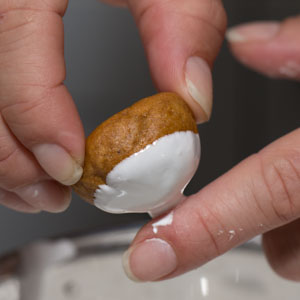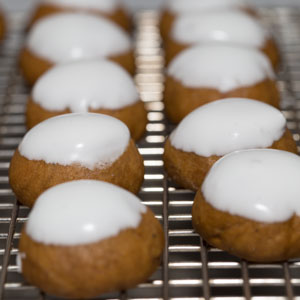Pfeffernüsse
introduction
Pfeffernüsse represent but one of many iterations of German Lebkuchen—a word which, itself, is rich in meaning and history. Lebkuchen translates to “gingerbread,” though a single English word poorly captures the phenomenon it represents. Quite possibly the oldest biscuit in the books, Lebkuchen emerged from cloisters and monasteries in different regions of 11th-century Germany in numerous permutations—honey cakes, spice bread, biscuits to break the fast and taken with strong beer, medicinal foods, savory or sweet—becoming what we know today as Lebkuchen only at the end of the 19th century when baking powders were introduced. Pfeffernüsse are members the Lebkuchen family, but to Americans, the little snow-capped artifacts pictured above compare more closely in flavor to molasses spice cookies than to gingerbread. As part one of a German compound noun, the word Pfeffer denotes spice (as it was known in the ancient world), not pepper, though many recipes, ours included, throw in a hit of black pepper and cayenne for flavor potentiation. Legend says the Nüsse, or nut, section of their name derives from their hard consistency. Like most German Christmas cookies, Pfeffernüsse are ancient. The Dutch, who call them “spice nuts” (that’s pepernoten to them), claim these cookies as their own. It’s not significant in the end, because both Pfeffernüsse and pepernoten remain attached to the celebration of Nikolaustag on December 6, when children traditionally left their cleaned shoes outside the door in the hope that St. Nicholas would fill them with candy and small gifts . . . like Pfeffernüsse.
The oldest Lebkuchen variants were made strictly with honey, demonstrating their pull back to Persia, cradle of all small sweetened biscuits, and later honey and sugar. In our baking trials, however, such Pfeffernüsse lacked the complexity and performance of the ones into which we spirited a measure of molasses—with this addition, the cookies’ entire countenance and character changed. (In many of their—we presume later—Pfeffernüsse recipes, Germans use sugar beet molasses.) Our Pfeffernüsse have a glassy-crisp royal icing crown and a bracing firmness in their texture that gives way to a slightly chewy, enticingly spicy bite. European Christmas flavors would be unrecognizable without anise, which fraternizes with other sweet spices familiar to Lebkuchen, making Christmas mystery pure magic.
Baking Notes
Comporting with their age and tradition, many German Christmas cookies use an ancient form of leavening called Hirschhornsalz. In the United States, it is known as baker’s ammonia (short for ammonium carbonate). The substance smells ghastly, but it does good things in baked goods (its odor dissipates at temperatures above 140 degrees). Because baker’s ammonia is not activated by liquid, but by heat, doughs made with it may be left to ripen in the refrigerator without suffering any loss of oven bounce. Cookies bake up crisp, with an open crumb, and stay crisp for long periods. King Arthur Flour sells baker’s ammonia.
Our Pfeffernüsse are tricky bakers. By any customary measure of doneness, they will feel overwhelmingly soft to the touch when they are actually done baking. Their bottoms should have taken on a nice brown hue; check the browning with a thin metal spatula. Leave them in the oven longer at your own peril—they’ll still taste great but will cool to veritable jaw breakers.
equipment mise en place
For this recipe, you will need a digital kitchen scale, a small bowl, a small saucepan, a silicone spatula, a large bowl, a wooden spoon, a gallon-size zipper-lock bag, two baking sheets, silicone baking mats or parchment paper, a metal bench knife, two wire racks, and a stand mixer fitted with the whisk attachment.
-
for the cookies:
-
½teaspoon baker’s ammonia
-
1teaspoon hot water
-
3.5ounces light molasses
-
3.5ounces honey
-
2.5ounces dark brown sugar
-
1.5ounces unsalted European-style butter
-
1teaspoon ground ginger
-
½teaspoon ground anise
-
½teaspoon ground cinnamon
-
¼teaspoon ground cardamom
-
⅛teaspoon ground cloves
-
¼teaspoon fine sea salt
-
¼teaspoon freshly ground black pepper
-
Pinch of cayenne
-
14
-
2teaspoons finely grated lemon zest
-
-
for the icing:
-
1ounce egg white
-
2teaspoons juice from 1 juicy lemon
-
5.5ounces confectioners’ sugar
-
-
Make the cookies: In a small bowl, combine the baker’s ammonia and hot water, stir to dissolve, and set aside. In a small saucepan, warm the molasses, honey, brown sugar, butter, ginger, anise, cinnamon, cardamom, cloves, salt, black pepper, and cayenne over medium-low heat, stirring with a silicone spatula, until the butter has melted and the sugar has dissolved, about 3 minutes. Remove from the heat and let cool for 10 minutes.
-
Put the flour in large bowl. Pour in the molasses mixture, add the lemon zest and dissolved baker’s ammonia, and stir with a wooden spoon (fig. 2.1) to form a fudgy, gingerbread-like dough (fig. 2.2). Turn the dough into a gallon-size zipper-lock bag, seal well, and refrigerate overnight.
-
Line 2 baking sheets with silicone mats or parchment paper. Divide the dough into 4 equal pieces and roll each piece into a 10-inch log on the countertop (fig. 3.1); the dough will roll easily without additional flour. Using a metal bench knife, cut bits of dough off the logs; each bit should weigh 0.3 ounce. Roll them into balls and place them 1½ inches apart on the prepared baking sheets (fig. 3.2). Let the cookies dry overnight, uncovered, at room temperature.
-
Adjust an oven rack to the lower-middle position and heat the oven to 325 degrees. Bake the cookies one baking sheet at a time until lightly browned on the bottoms, 12 to 14 minutes; they will feel quite soft to the touch, but will firm up as they cool. Let cool on the baking sheet for about 2 minutes, and then transfer the cookies to a wire rack. Let cool completely.
-
Make and apply the icing: Combine the egg white, lemon juice, and confectioners’ sugar in the bowl of a stand mixer fitted with the whisk attachment. Beat on medium speed until the mixture is opaque, glossy, and thick and holds stiff peaks, 5 to 7 minutes. Working one at a time, dip the tops of cookies in the icing, allowing some of the icing to drip back into the bowl (fig. 5.1), and then use the side of your forefinger and a hooking motion to remove the excess (fig. 5.2), leaving a perfect cap on top. Return the cookie, upright, to the wire rack (fig. 5.3). Let the glaze dry completely. Store the pffernüsse in an airtight container for up to 1 month.
-
-
2.1

-
2.2

-
-
-
3.1

-
3.2

-
-
-
5.1

-
5.2

-
5.3

-